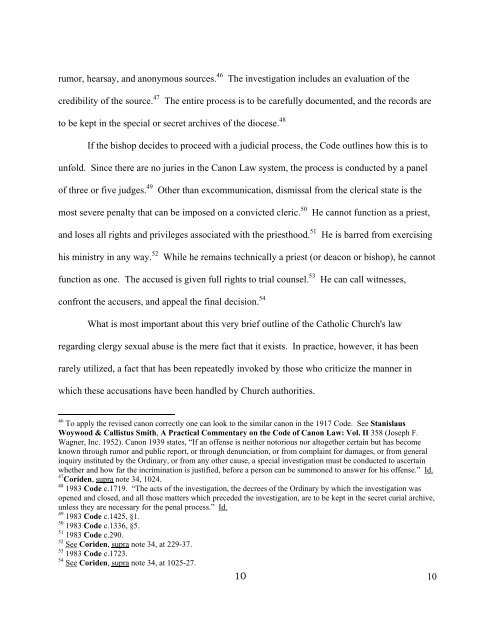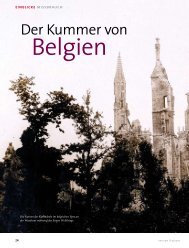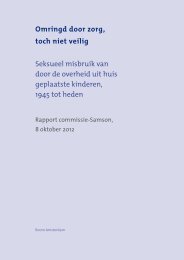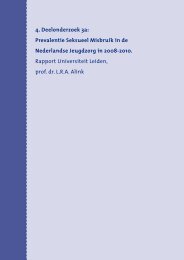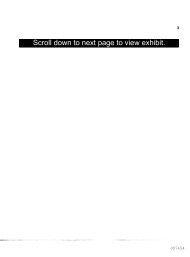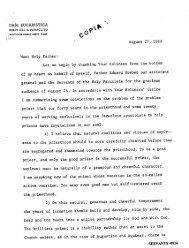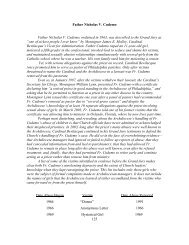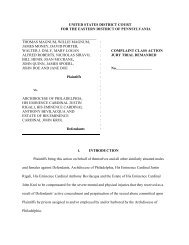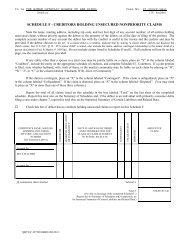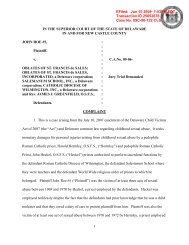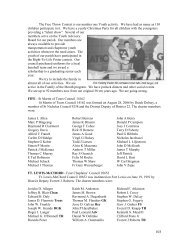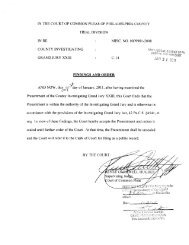1 1 Catholic Clergy Sexual Abuse Meets the Civil Law by Thomas P ...
1 1 Catholic Clergy Sexual Abuse Meets the Civil Law by Thomas P ...
1 1 Catholic Clergy Sexual Abuse Meets the Civil Law by Thomas P ...
Create successful ePaper yourself
Turn your PDF publications into a flip-book with our unique Google optimized e-Paper software.
umor, hearsay, and anonymous sources. 46 The investigation includes an evaluation of <strong>the</strong><br />
credibility of <strong>the</strong> source. 47 The entire process is to be carefully documented, and <strong>the</strong> records are<br />
to be kept in <strong>the</strong> special or secret archives of <strong>the</strong> diocese. 48<br />
If <strong>the</strong> bishop decides to proceed with a judicial process, <strong>the</strong> Code outlines how this is to<br />
unfold. Since <strong>the</strong>re are no juries in <strong>the</strong> Canon <strong>Law</strong> system, <strong>the</strong> process is conducted <strong>by</strong> a panel<br />
of three or five judges. 49 O<strong>the</strong>r than excommunication, dismissal from <strong>the</strong> clerical state is <strong>the</strong><br />
most severe penalty that can be imposed on a convicted cleric. 50 He cannot function as a priest,<br />
and loses all rights and privileges associated with <strong>the</strong> priesthood. 51 He is barred from exercising<br />
his ministry in any way. 52 While he remains technically a priest (or deacon or bishop), he cannot<br />
function as one. The accused is given full rights to trial counsel. 53 He can call witnesses,<br />
confront <strong>the</strong> accusers, and appeal <strong>the</strong> final decision. 54<br />
What is most important about this very brief outline of <strong>the</strong> <strong>Catholic</strong> Church's law<br />
regarding clergy sexual abuse is <strong>the</strong> mere fact that it exists. In practice, however, it has been<br />
rarely utilized, a fact that has been repeatedly invoked <strong>by</strong> those who criticize <strong>the</strong> manner in<br />
which <strong>the</strong>se accusations have been handled <strong>by</strong> Church authorities.<br />
46 To apply <strong>the</strong> revised canon correctly one can look to <strong>the</strong> similar canon in <strong>the</strong> 1917 Code. See Stanislaus<br />
Woywood & Callistus Smith, A Practical Commentary on <strong>the</strong> Code of Canon <strong>Law</strong>: Vol. II 358 (Joseph F.<br />
Wagner, Inc. 1952). Canon 1939 states, “If an offense is nei<strong>the</strong>r notorious nor altoge<strong>the</strong>r certain but has become<br />
known through rumor and public report, or through denunciation, or from complaint for damages, or from general<br />
inquiry instituted <strong>by</strong> <strong>the</strong> Ordinary, or from any o<strong>the</strong>r cause, a special investigation must be conducted to ascertain<br />
whe<strong>the</strong>r and how far <strong>the</strong> incrimination is justified, before a person can be summoned to answer for his offense.” Id.<br />
47 Coriden, supra note 34, 1024.<br />
48 1983 Code c.1719. “The acts of <strong>the</strong> investigation, <strong>the</strong> decrees of <strong>the</strong> Ordinary <strong>by</strong> which <strong>the</strong> investigation was<br />
opened and closed, and all those matters which preceded <strong>the</strong> investigation, are to be kept in <strong>the</strong> secret curial archive,<br />
unless <strong>the</strong>y are necessary for <strong>the</strong> penal process.” Id.<br />
49 1983 Code c.1425, §1.<br />
50 1983 Code c.1336, §5.<br />
51 1983 Code c.290.<br />
52 See Coriden, supra note 34, at 229-37.<br />
53 1983 Code c.1723.<br />
54 See Coriden, supra note 34, at 1025-27.<br />
10<br />
10


